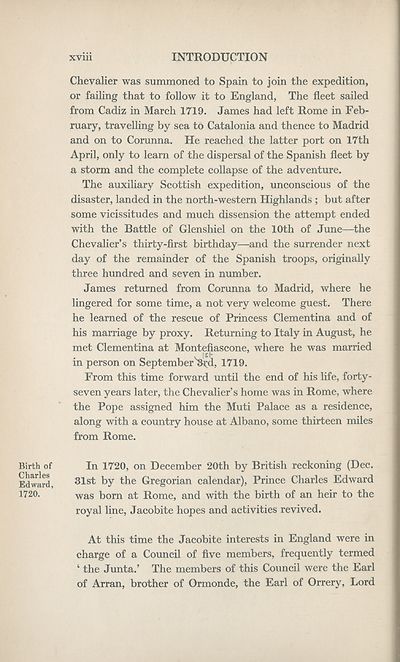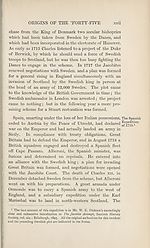Series 2 > Origins of the 'Forty-five
(27) Page xviii
Download files
Complete book:
Individual page:
Thumbnail gallery: Grid view | List view

Birth of
Charles
Edward,
1720.
xviii INTRODUCTION
Chevalier was summoned to Spain to join the expedition,
or failing that to follow it to England, The fleet sailed
from Cadiz in March 1719. James had left Rome in Feb¬
ruary, travelling by sea to Catalonia and thence to Madrid
and on to Corunna. He reached the latter port on 17th
April, only to learn of the dispersal of the Spanish fleet by
a storm and the complete collapse of the adventure.
The auxiliary Scottish expedition, unconscious of the
disaster, landed in the north-western Highlands ; but after
some vicissitudes and much dissension the attempt ended
with the Battle of Glenshiel on the 10th of June—the
Chevalier’s thirty-first birthday—and the surrender next
day of the remainder of the Spanish troops, originally
three hundred and seven in number.
James returned from Corunna to Madrid, where he
lingered for some time, a not very welcome guest. There
he learned of the rescue of Princess Clementina and of
his marriage by proxy. Returning to Italy in August, he
met Clementina at Montefiascone, where he was married
in person on September^d, 1719.
From this time forward until the end of his life, forty-
seven years later, the Chevalier’s home was in Rome, where
the Pope assigned him the Muti Palace as a residence,
along with a country house at Albano, some thirteen miles
from Rome.
In 1720, on December 20th by British reckoning (Dec.
31st by the Gregorian calendar), Prince Charles Edward
was born at Rome, and with the birth of an heir to the
royal line, Jacobite hopes and activities revived.
At this time the Jacobite interests in England were in
charge of a Council of five members, frequently termed
‘ the Junta.’ The members of this Council were the Earl
of Arran, brother of Ormonde, the Earl of Orrery, Lord
Charles
Edward,
1720.
xviii INTRODUCTION
Chevalier was summoned to Spain to join the expedition,
or failing that to follow it to England, The fleet sailed
from Cadiz in March 1719. James had left Rome in Feb¬
ruary, travelling by sea to Catalonia and thence to Madrid
and on to Corunna. He reached the latter port on 17th
April, only to learn of the dispersal of the Spanish fleet by
a storm and the complete collapse of the adventure.
The auxiliary Scottish expedition, unconscious of the
disaster, landed in the north-western Highlands ; but after
some vicissitudes and much dissension the attempt ended
with the Battle of Glenshiel on the 10th of June—the
Chevalier’s thirty-first birthday—and the surrender next
day of the remainder of the Spanish troops, originally
three hundred and seven in number.
James returned from Corunna to Madrid, where he
lingered for some time, a not very welcome guest. There
he learned of the rescue of Princess Clementina and of
his marriage by proxy. Returning to Italy in August, he
met Clementina at Montefiascone, where he was married
in person on September^d, 1719.
From this time forward until the end of his life, forty-
seven years later, the Chevalier’s home was in Rome, where
the Pope assigned him the Muti Palace as a residence,
along with a country house at Albano, some thirteen miles
from Rome.
In 1720, on December 20th by British reckoning (Dec.
31st by the Gregorian calendar), Prince Charles Edward
was born at Rome, and with the birth of an heir to the
royal line, Jacobite hopes and activities revived.
At this time the Jacobite interests in England were in
charge of a Council of five members, frequently termed
‘ the Junta.’ The members of this Council were the Earl
of Arran, brother of Ormonde, the Earl of Orrery, Lord
Set display mode to:
![]() Universal Viewer |
Universal Viewer | ![]() Mirador |
Large image | Transcription
Mirador |
Large image | Transcription
Images and transcriptions on this page, including medium image downloads, may be used under the Creative Commons Attribution 4.0 International Licence unless otherwise stated. ![]()
| Scottish History Society volumes > Series 2 > Origins of the 'Forty-five > (27) Page xviii |
|---|
| Permanent URL | https://digital.nls.uk/126859515 |
|---|
| Attribution and copyright: |
|
|---|
| Description | Over 180 volumes, published by the Scottish History Society, containing original sources on Scotland's history and people. With a wide range of subjects, the books collectively cover all periods from the 12th to 20th centuries, and reflect changing trends in Scottish history. Sources are accompanied by scholarly interpretation, references and bibliographies. Volumes are usually published annually, and more digitised volumes will be added as they become available. |
|---|


